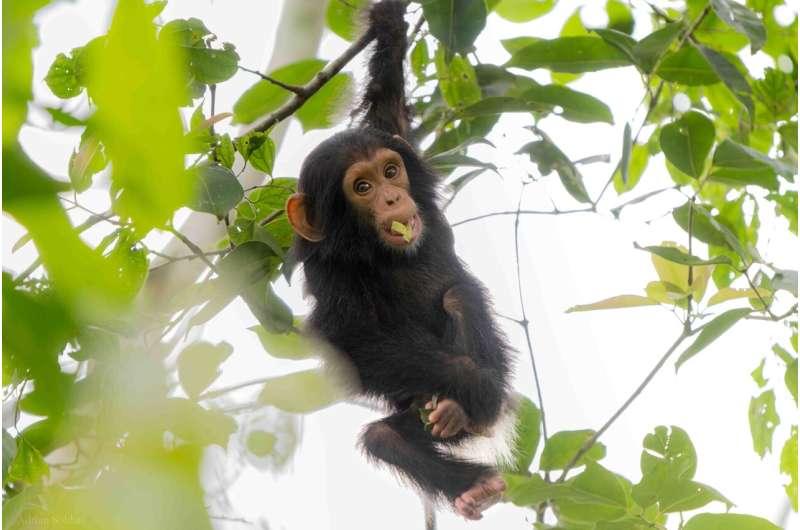This article has been reviewed according to Science X's editorial process and policies. Editors have highlighted the following attributes while ensuring the content's credibility:
fact-checked
peer-reviewed publication
trusted source
proofread
Researchers discover chimpanzee communities have local gestural dialects

Researchers from the University of St Andrews have found that chimpanzees in two neighboring communities in the Budongo Forest, Uganda, use leaf gestures in different dialects to communicate with members of their group.
The study, published on Jan. 5 in Scientific Reports, shows that a community of chimpanzees will use their own preferred form of leaf-modifying gesture, and that neighboring groups can use different ones, so that each group has its own gestural dialects.
Gestural communication is an integral part of chimpanzee social lives. Chimpanzees use gestures to ask for food, navigate social interactions, and make up after fights. Gestures come in many forms: some are performed only using the hands, some include touching another individual, and others involve the manipulation of common objects found in the chimpanzees' environment, like sticks, trees, and leaves.
For example, leaf gestures can include modifying the leaves by tearing or ripping them with a distinctive sound or pulling them off the stem, just like plucking the petals off a daisy—"she loves me, she loves me not." These leaf-modifying gestures look very similar to each other and have been seen in almost all the communities of chimpanzees studied from East to West Africa. But, for the first time, researchers have now shown that each group maintains its own style or dialect of leaf-modifying gestures, and that these differences cannot be explained by differences in their forest environment or genetics.
Lead author Gal Badihi said, "Like human dialects, the different forms of gestures used by the two communities are used in the same contexts and seem to have the same meaning. It makes me think of the song 'you say Potayto, I say Potaato'; it's the same word, with the same meaning, but with a different pronunciation."
Dialects are often considered a fundamentally cultural component of human and non-human animal societies. While chimpanzees have been shown to be very good at learning socially from each other—such as how to make the right tool—scientists have rarely found any evidence that their social environment also shapes their communication. This new finding suggests that like other proficient animal communicators—including songbirds, whales, and humans—chimpanzees socially learn some aspects of their gestural communication.
Senior author Dr. Cat Hobaiter said, "These gestures are quite common, but in the thick forest it can be hard to see the details—so we tried our hand at a little chimpanzee 'archaeology.' After the chimps had finished gesturing, we would go along and look at the leaf remains. Each way of tearing the leaves left a different pattern—so we could work out who was using which style."
She added, "They use these leaf-modifying gestures for a few reasons, but the most common reason chimpanzees in Budongo use them is as a sort of gestural 'pick-up line'—they're the equivalent of chimpanzee flirting; and it turns out that even once you've plucked up the courage to ask the girl if she's interested, you also need to know how to do it in the local 'style.'"
Gal Badihi added, "Interestingly, it also looks like females who moved between communities were able to understand the dialect of the community they moved into. This shows that chimpanzees can flexibly learn to use and understand 'foreign' dialects throughout their lives, even as adults."
The paper, "Dialects in leaf-clipping and other leaf-modifying gestures between neighboring communities of East African Chimpanzees," is published in Scientific Reports.
More information: Gal Badihi et al, Dialects in leaf-clipping and other leaf-modifying gestures between neighbouring communities of East African chimpanzees, Scientific Reports (2023). DOI: 10.1038/s41598-022-25814-x
Journal information: Scientific Reports
Provided by University of St Andrews



















